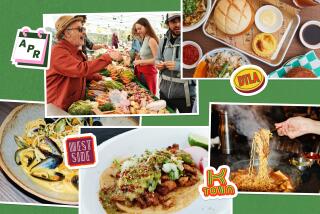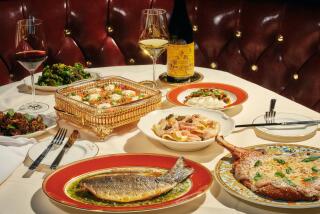In Macao, Portuguese on the Side
- Share via
MACAO — The frenetic pace that makes Hong Kong so addictive is reason enough for the visitor to escape, even for a day, to the fascinating settlement of Macao.
The Chinese territory, under Portuguese administration (until December 1999, when it returns to Chinese rule), is 40 miles west of Hong Kong and consists of a small, fat peninsula (about 6.1 square miles), where most business is conducted, and two small islands (Colo^ane and Taipa), all connected by bridges.
For decades, Hong Kong locals as well as tourists and Chinese from Taiwan and mainland China have regarded Macao as a haven of pleasure where gambling, racing (dog and horse) and nightclubs invite.
All that still exists. But so does excellent dining, antique shopping and colonial architecture, amid gleaming skyscrapers and Portuguese ambience.
A 50-minute hydrofoil ride from Hong Kong, the Portuguese enclave is home to a laid-back style of hospitality, as well as restaurants specializing in Portuguese and Macanese (a blend of Chinese and Portuguese) cooking.
About 40 of Macao’s 120 restaurants serve Portuguese or Macanese food, which evolved from the Portuguese traders who arrived around 1557 and established trading posts here. They married Asian women who, unable to find European ingredients, substituted Chinese ingredients in the Portuguese dishes and created a new cuisine.
I lived in Hong Kong for seven years until spring 1996, and a day or a weekend in Macao meant three-hour lunches and long-simmered stews with spicy sausages and crusty rolls to sop up the sauce or dark green olive oil. It also meant endless variations on codfish, great tomato salads and eggy desserts that enrich cardiologists and leave the rest of us feeling guilty.
Service is never rushed, although it is often uneven, but always with a smile. Whether arriving or leaving, Macao always gave us reasons to order another glass of vinho verde (young fruity wine) and linger through the sunset.
It also meant dining at favorite spots such as Fernando’s, A Lorcha, Clube Militar de Macao (the Military Club) and Restaurante Litoral, and never leaving without a heavenly egg tart (called nata) from Lord Stow’s Bakery. These were the rewards for surviving another week in harried Hong Kong. Or the antidote for nearly anything.
To refresh my culinary memory, I recently returned for a week in Macao, where I found I still adore the places that follow, where we ate once again. But be advised: Macao on weekends is a magnet for tourists and gamblers (there are 12 casinos and a racetrack), making restaurant and hydrofoil reservations necessary. Monday through Thursday, Macao is easier to manage, with fewer lines and people.
*
Fernando Gomes didn’t know how to cook when he opened Fernando’s on Hac Sa Beach in 1986. A native of the Azores, he is as much a personality and storyteller as he is one of Macao’s most successful and outspoken restaurateurs.
The atmosphere at his haphazard 170-seat restaurant on the island of Colo^ane is something like a picnic with a roof overhead. Windows are flung open year-round, the open kitchen is hardly designer-handsome. But simple, grilled, wine-washed meals of Portuguese derivation are the drawing cards.
The lanky Gomes is usually there, holding court at the outdoor bar. Among my favorite dishes are caldo verde (potato-thickened kale soup); clams in a piquant tomato, garlic, coriander and olive oil sauce; succulent fried crab; crispy grilled sardines and a chicken that’s dry-basted in spices, grilled and served on a plateful of perfect French fries. The basket of crusty rolls has no bottom. The house salad of lettuce, sweet onion and tomato is so fresh it needs little more than a drizzle of olive oil and coarse salt. Rarely is there room for dessert, but several diners can usually manage a pudim (dense burnt-milk custard) and coffee. The beach is the next stop for a siesta. Lunch for three with wine and coffee was $65.
*
Before she opened Restaurante Litoral in 1995, Manuela Ferreira was a civil servant. The mother of three and native of Macao also was known as a terrific cook with a stash of recipes from four generations. She retired early to pursue her cooking passions and the result is her two-story restaurant, which is considered upscale by locals, with its polished stone floors, Portuguese blue tile, dark wood trim and creamy stucco walls decorated with European and Macanese artifacts.
Government officials frequent Litoral for business lunches and special dinners. Despite the 90-minute lunch hour observed by most office workers, it is not uncommon to see politicians sally down the stairs of the 140-seat restaurant after three-hour lunches. Ferreira seems to know everyone by their first names.
Her menu is about two-thirds Portuguese, but there are several Macanese dishes (none are described as such but, on request, waitresses will point them out). Her version of caldo verde is finer than most porridge-style versions found in Macao. A portion won’t ruin the appetite. The appetizers alone suffice as a meal. But the squid in vinegar and chamussas (crispy phyllo triangles stuffed with curried ground beef with a kick of chile) are perfect to share.
Don’t miss bacalao Litoral-style, a baked cod casserole with potatoes and onion, garnished with hard-cooked egg and slivers of ham. It’s hearty to a fault, simple and totally addictive. The baked stuffed crab (two pieces to a serving) with cream sauce, is as rich as a dessert. But that didn’t stop us from ordering a flan-like coconut milk custard (bebinca de leite) and biscuit mousse (serradura), a dense milk custard sprinkled with crushed cookie crumbs (hence the name that translates as “sawdust”).
The richness of the crab and dessert was cut with a fine vinho verde and some espresso. Our intentions to walk back to the hotel were excused by a downpour. Dinner for three with wine and coffee was $80.
By 1880 there was a glut of construction going on in Macao. The Portuguese traders were thriving. So was the economy. The Military Club on the Avenida da Praia Grande was established for Portuguese military officers and their families. The building with its coral-colored colonial facade, arched windows and vast veranda was off-limits to anyone but officers and their guests. It offered carpeted game rooms, lounges with huge sofas and reading chairs, a bar and a restaurant.
Three years ago the building underwent renovation, and in 1995, the restaurant opened to the public for lunch, afternoon tea and dinner seven days a week. (Only club members and members of affiliated clubs are allowed in the bar, lounge and game rooms.)
The dining room salutes the refinement of a past era with highly polished floors and ceiling fans, meticulous floral arrangements and sideboards with silver tea sets and Chinese porcelain. Sheer curtains allow the afternoon light to highlight the wood floor. Lights dim in the evening when candles come out. Paintings by Nuno Barreto, a contemporary Portuguese artist living in Macao, add a blaze of color to the creamy walls. Patrons visit for the atmosphere and excellent service as well as the Portuguese food, which is very good.
One appetizer, a custardy blend of scrambled eggs with asparagus and spicy sausage, was out of this world. So was the combination plate of salads: codfish and pork, each marinated yet distinct, and tapenade, an acidic black olive paste, to slather on rolls. African chicken (a recipe brought by traders in the 1700s from Mozambique) came with a lush peanut sauce. The dessert buffet included a lovely egg tart dusted with cinnamon, Portuguese cheeses, coconut pudding, cheesecake and apple crumble. Dinner for three with wine and coffee was $100.
*
A Lorcha serves home-style Portuguese cooking at its best. The 90-seat restaurant, opened in 1989, is named after a three-masted Portuguese sailing ship common to the South China Sea centuries ago. Run by Adriano Neves and his mother, Maria, the restaurant is divided into two long, narrow rooms with dark wood, subtle lighting and textured stucco walls.
The food and the service are excellent. Seafood and stews are noteworthy and portions are huge. Cruets of heady flavored olive oil find crusty partners in the bread basket.
Favorite dishes include baked crab; grilled pork with clams in a buttery sauce spiked with lemon; a stew of broad beans with sausage in a thick, rich paprika-infused gravy and a chunky codfish salad riddled with garlic and tossed with coriander, tomato and onion.
A Lorcha makes the most irresistible version of serradura (a dense custard of double cream and eggs that’s topped with ground biscuit).
Dinner for three with wine and coffee was $80. On weekends, reservations are a must.
*
No matter how stuffed I am from many eating marathons in Macao I always make room for nata from Lord Stow’s Bakery. Imagine creme bru^lee in a buttery puff pastry shell and you understand these egg tarts. Stow, a British national and pharmacist, arrived in Macao in the late ‘70s to run a pharmaceutical company. But he ended up managing a hotel’s nightclub.
In 1989, he opened a bakery in a converted garage in Colo^ane Village on Colo^ane island, catering to the locals and the restaurant trade. One of his goals was to make the best nata outside of Portugal. He gets my vote.
Stowe’s nata are the size of a silver dollar, sell for 55 cents, and should be eaten warm with a sprinkling of cinnamon. They’re worth every calorie.
Sheridan is a food writer for The Times.
(BEGIN TEXT OF INFOBOX / INFOGRAPHIC)
GUIDEBOOK: Macao Meals
Getting there: The Macao ferry pier in Hong Kong is at the Shun Tak Center in Sheung Wan district, Hong Kong Island. It is easy to get to via MTR (subway); take it to Sheung Wan station and watch for direction signs to the ferry terminal.
Hydrofoils (50 minutes) are the fastest sea transportation between Hong Kong and Macao. Turbocats (jet-powered catamarans) take about 65 minutes, and Hong Kong Ferries (two-deck crafts) take 95 minutes. Book ferries in advance for the weekend. Ferries run 24 hours with reduced schedules between 10 p.m. and 7 a.m. Weekdays, arrive at the pier at least 45 minutes in advance; allow more time on weekends. Expect long lines at the immigration checkpoint.
First class on the hydrofoil (Hong Kong to Macao) is about $18 (one-way, mid-week); economy class is $16 (one-way mid-week). Fares are slightly higher ($2 to $3 more) on weekends or early evening. There is a departure tax of $3. Hydrofoil tickets can be purchased at the Pier or through MTR Travel Service Centers in many subway stations.
Far East Jetfoil Co. Ltd., Sheung Tak Center, 200 Connaught Road, Sheung Wan; local telephone, 2859-6596.
Where to eat: A Lorcha, 289A Rua do Almirante Sergio, Macao. (Closed Tuesday.) Appetizers about $4, entrees $8 to $10. Major credit cards accepted; tel. (853) 313-195.
Fernando’s, 9 Praia de Hac Sa, Colo^ane Island. Appetizers about $5, entrees $9 to $12. Cash only; tel. (853) 882-264q.
Lord Stow’s Bakery, Colo^ane Town Square, Colo^ane Island. Sandwiches, coffee, soft drinks, bread, rolls and nata (egg tarts) from 50 cents. Cash only; tel. (853) 882-534. (Stow also has a good bakery/sandwich shop in Macao: Cafe e Nata Sandwich Bar, Gum Loi Building, Rua Alm. Costa Cabral; tel. [853] 710-032.)
Military Club (Clube Militar de Macao), 795 Avenida da Praia Grande, Macao. Appetizers about $5 to $9, entrees $10 to $14. Visa cards accepted; tel. (853) 714-009.
Restaurante Litoral, 261A Rua do Almirante Sergio, Macao. Appetizers about $4, entrees $8 to $10. Major credit cards accepted; tel. (853) 967-878.
For more information: Macao Tourist Information Bureau, P.O. Box 350, Kenilworth, IL 60043; (800) 331-7150, fax (847) 256-5601.
More to Read
Sign up for The Wild
We’ll help you find the best places to hike, bike and run, as well as the perfect silent spots for meditation and yoga.
You may occasionally receive promotional content from the Los Angeles Times.






